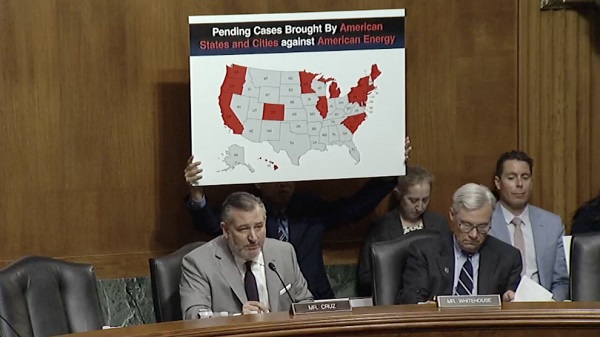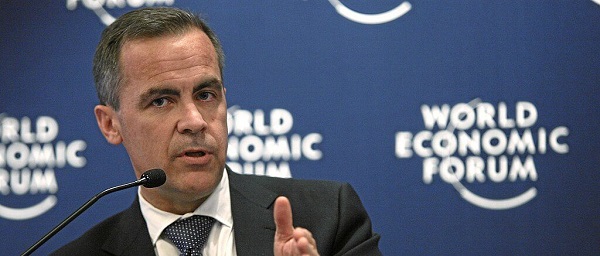Energy
Canada’s Most Impactful Energy Issues in 2024

From EnergyNow.ca
By Deidra Garyk
It feels like we are in the beginning of a cultural, social, and political disruption. The fear of saying the wrong thing and being cancelled is subsiding, resulting in robust debate about important topics. Public pushback against climate alarmism and energy misinformation is getting louder as more and more people join in the discussion.
I have enjoyed watching the increased skepticism and distrust towards “the settled Science” and the agreed upon narratives in favour of open, genuine, inquisitive conversations with a focus on practicable solutions. People are fed up with niche topics taking up a disproportionate amount of airtime in place of issues that are relevant to the majority of the country.
These are a few of the energy topics that I feel were most impactful for the year, with many having a lasting impact into 2025 and beyond.
SHIFTING POLITICAL WINDS
As Canada implements more and more regulatory hurdles for the oil and gas industry, the US re-elected pro-business, pro-oil, political outsider Donald Trump in a ‘uge win, with the majority of counties shifting from blue (Democrat) to red (Republican).

He isn’t even sworn in, and Trump is lighting things up via social media decrees. Using Truth Social, he announced that a 25 percent tariff will be placed on all goods coming from Canada and Mexico unless their respective borders are addressed to his satisfaction.
This will affect all Canadian businesses, not the least being those in the oil patch since 4 million barrels of oil per day go to the US, along with 7.9 billion cubic feet per day of natural gas. 77 percent of Canadian exports enter the US market; therefore, a 25 percent tariff is another obstacle affecting Canadian businesses’ competitiveness, which are already faced with various regulatory and taxation hurdles from Canadian governments, such as the carbon tax that increases each year.
Expect to see a shake-up in the Department of Energy and the narrative around climate and energy with the nomination of Chris Wright, CEO of Liberty Energy, for US Secretary of Energy. Chris has been a bold, unapologetic, pragmatic energy realist who cares about balancing environmental responsibility with resource development to help supply the world with reliable, affordable energy. His principled leadership has elevated him to one of the highest offices in the US.
Chris Wright is not afraid to go against the crowd. Liberty successfully challenged the SEC’s climate reporting rules and were instrumental in getting them halted. You can listen to his clarity of thought as he testifies on the rules before the U.S. House of Representatives’ Financial Services Committee (Chris’ testimony starts at 53:58).
As the first energy secretary to come from the energy sector, I anticipate that the government’s energy messaging and policy is going to shift away from climate alarmism to one of balance and open-mindedness. I hope he staffs the Department with people who understand energy and are not focused on misguided ideology. The ripple effects will be felt around the globe, and now is the time to embrace people’s scepticism and exhaustion with the constant drumbeat of fear about the use of hydrocarbons.
Much like the massive political shift voted in by the Americans, Canadians are also ready for a change. Prime Minister Trudeau and his Liberal party continue to lag in the polls, indicating voters’ displeasure with their policies. Poll aggregator 338Canada predicts a resounding majority for the federal Conservatives. Will we begin to see better energy policy after the next election?

RENEWABLES’ REALITY AND COOLING CLIMATE CLUBS
As a further demonstration of the shifting social and political winds, the net zero climate movement has seen major companies quell their public support for associated initiatives. The appetite for costly net zero commitments from voters who are struggling to pay their bills is waning, and politicians are hearing about it.
Many Republican-led states have pushed back on anti-hydrocarbon, net zero financing, and that has influenced how companies behave, starting with an exodus from Mark Carney’s net zero alliance, GFANZ (Glasgow Financial Alliance for Net Zero). The Net-Zero Insurance Alliance (NZIA), a subset of GFANZ, has lost about half of its members since March 2023. Climate initiatives, like Climate Action 100+ and the Net Zero Banking Alliance (NZBA) are also losing members who are concerned about the consequences of their affiliation with anti-hydrocarbon groups who attempt to influence how businesses conduct their operations, sometimes through coercive involuntary membership and social shaming.
The energy transition continues to face opposition. In summer 2023, the Alberta government placed a temporary, six-month moratorium on renewable energy – wind and solar – projects in an attempt to balance development with agricultural and social concerns. The condemnation from environmental groups and the Alberta NDP was swift and loud, but not always truthful. On the other side were landowners who were concerned about the consequences of the projects on their communities. A documentary, Generation Green, by filmmaker Heidi McKillop, documents the push-pull of renewable project development in Alberta.
The new rules include development limits on certain agricultural lands, protection of viewscapes using buffer zones, and a requirement for an upfront bond to pay for future reclamation costs. Landowners and associations have praised the changes for addressing concerns and being balanced.
January’s polar vortex reconfirmed people’s willingness to rethink some large-scale industrial wind and solar installations. The extreme cold resulted in alerts warning of potential rotating blackouts, reminding Albertans about the need for reliable, affordable, on-demand energy.
At the same time that Canadians are questioning the reliability of our grids, the government went all in on their bet on the adoption of electric vehicles, generously giving EV battery makers billions of taxpayer-funded subsidies to set up shop in Canada. However, plans have hit speed bumps (pun intended).
Sweden’s Northvolt, the recipient of $7.3 billion in loans, equity stakes, and subsidies from Canada, recently filed for bankruptcy protection in the US. The company says this will not affect its Canadian plant, which is being used as collateral to secure bailout financing in the US. Meanwhile, other plants have been delayed. It seems like this may not have been a good “investment” for taxpayers.
Not that the Liberal government has been cautious with our money. Sustainable Development Technology Canada, colloquially referred to as the green slush fund, violated government funding rules and breached conflict-of-interest and ethics laws by improperly giving away millions of dollars. The scandal is so bad that the RCMP are investigating whether or not there was criminal wrongdoing; however, the government has been at a standstill for weeks because the Liberals refuse to hand over documents to help with the investigation.
COP29, THE FINANCE COP(S)
The COP conflab in Baku, Azerbaijan, in November didn’t skip a beat, seemingly ignorant of the shifting support for costly environmental action predicated on alarmism. Its 65,000 delegates waxed lyrical about the need to transfer funds from developed nations who are allegedly responsible for climate change to developing nations who are disproportionately victimized by changing weather conditions. What was dubbed “the New Collective Quantified Goal” (NCQG) on climate finance, governments tripled their handouts to US$300 billion annually by 2035, and got commits from public and private entities to increase that funding to US$1.3 trillion per year by 2035.
No one likes spending other people’s money quite like Minister Steven Guilbeault. You can find a daily outline of Canada’s COP commitments here.
We should have a new environment minister in time for COP30 in Brazil. And thankfully so, my wallet can’t take much more!
REGULATORY RAT’S NEST
In June, with the passage of Bill C-59, the Canadian Competition Act was amended with expanded provisions to address greenwashing complaints, including excessively punitive charges for breaking the new rules. The gag order has silenced oil and gas companies. Many, such as the Pathways Alliance of the six biggest oilsands producers, took down their websites immediately after the changes were announced. Others took down their ESG reports and environmental statements.
Even though oil and gas is likely to be disproportionately targeted and penalized, this Bill is agnostic; complaints can be made against all industries, and the unelected, unaccountable bureaucracy will decide who will and will not be investigated.
The fines are material. $750,000 for an individual’s first offence and $10 million per misrepresentation for a company’s first offense, up to 3% of annual worldwide gross revenues. Analysis from one of the Big Four consulting firms uncovered approximately one potential misrepresentation per page of an ESG report; some reports run close to 100 pages, so the consequences of a fine are impactful, hence the swift reaction from companies.
While business leaders navigate the landmines created by C-59, mandatory sustainability (i.e. ESG) reporting standards are expected to be rolled out next year, with the latest draft issued in the next week or two. The Canadian securities regulator has said they are focused on climate as the first reporting topic. Nevertheless, it is reasonable to expect the Canadian standards will be expanded as the international standards broaden to include biodiversity and human capital, and possibly “just transition”.
In addition to the requirements for publicly traded companies, the feds’ announced mandatory climate reporting for all large, Canadian incorporated companies, including private. Corporations will be forced to publicly disclose their environmental performance while also being hamstrung by the greenwashing changes.
If you feel like an Olympian high jumper, it may be because companies have to be to meet ever higher regulatory requirements set by our federal government. Just when companies think they’ve cleared the bar by voluntarily cutting emissions from production, the feds raise it one foot higher.
November 4 brought the long-awaited draft emissions cap for the oil and gas industry, targeting a 35 percent emissions reduction below 2019 levels by 2030. To say the industry is annoyed is an understatement, and rightfully so.
You can’t keep a good industry down, though! The Canadian Association of Energy Contractors (CAOEC) is forecasting drilling growth in 2025, meaning the industry and its jobs are maintaining a positive trajectory. There’s continued optimism in the patch thanks to increased egress capacity following the start-up of TMX and the near completion of LNG Canada. The CAOEC 2025 forecast anticipates a total of 6,604 wells drilled, a 5.2% increase in rig operating hours, and total jobs (direct and indirect) of 41,800 – all up from 2024. This is good for workers, families, communities, and the economy.
PIPELINE EGRESS PROGRESS
The long-delayed, over-cost Trans Mountain Expansion Project (TMX) became operational on May 1, 2024, proving that we can still build things in Canada. The pipeline allows for the transportation of up to 890,000 barrels per day of oil to the west coast, which has helped narrow the differential of Western Canada Select crude. Congrats to everyone who worked on the project!
Another project of significant national importance is the 670 kilometre Coastal GasLink (CGL), the first pipeline built to the west coast in 70 years. Although the historical pipeline was completed ahead of schedule in late 2023, its completion affected the drilling and development plans of companies this year as we wait for the start up of the LNG Canada facility in 2025. CGL is another reason for optimism.
PERSONAL HIGHLIGHTS AND MILESTONES
2024 marks 20 years in the patch for me. I’ve had the opportunity to work alongside many astute, industrious, innovative folks who have integrity and heart for their work and co-workers. I thank each of you for shaping my career.
In February, I moderated EnergyNow’s event The Road Ahead: Alberta Energy 2024 with Minister of Energy and Minerals Brian Jean and distinguished energy analyst Dave Yager. We sold out the Petroleum Club ballroom and filled the room with lively discussion and camaraderie.
I then had the honour of moderating the sold-out luncheon panel at the 2024 Lloydminster Heavy Oil Show in September, featuring Alberta Premier Danielle Smith and Saskatchewan Premier Scott Moe. They graciously answered my questions, including one on the Keystone Pipeline – the new “hot topic”.
Premier Smith predicted that a change in US government could see the project resurrected. The Republicans took control of the White House, the Senate, and the House, so we will see if the Premier gets her wish. You can listen to her full answer here and a shorter clip here.
As we close off another fortunate year, I wish all the best for 2025.
Deidra Garyk is the Founder and President of Equipois:ability Advisory, a consulting firm specializing in sustainability solutions. Over 20 years in the Canadian energy sector, Deidra held key roles, where she focused on a broad range of initiatives, from sustainability reporting to fostering collaboration among industry stakeholders through her work in joint venture contracts.
Outside of her professional commitments, Deidra is an energy advocate and a recognized thought leader. She is passionate about promoting balanced, fact-based discussions on energy policy, and sustainability. Through her research, writing, and public speaking, Deidra seeks to advance a more informed and pragmatic dialogue on the future of energy.
Energy
China undermining American energy independence, report says

From The Center Square
By
The Chinese Communist Party is exploiting the left’s green energy movement to hurt American energy independence, according to a new report from State Armor.
Michael Lucci, founder and CEO of State Armor, says the report shows how Energy Foundation China funds green energy initiatives that make America more reliant on China, especially on technology with known vulnerabilities.
“Our report exposes how Energy Foundation China functions not as an independent nonprofit, but as a vehicle advancing the strategic interests of the Chinese Communist Party by funding U.S. green energy initiatives to shift American supply chains toward Beijing and undermine our energy security,” Lucci said in a statement before the Senate Judiciary Subcommittee’s hearing on Wednesday titled “Enter the Dragon – China and the Left’s Lawfare Against American Energy Dominance.”
Lucci said the group’s operations represent a textbook example of Chinese influence in America.
“This is a very good example of how the Chinese Communist Party operates influence operations within the United States. I would actually describe it as a perfect case study from their perspective,” he told The Center Square in a phone interview. “They’re using American money to leverage American policy changes that make the American energy grid dependent upon China.”
Lucci said one of the most concerning findings is that China-backed technology entering the U.S. power grid includes components with “undisclosed back doors” – posing a direct threat to the power grid.
“These are not actually green tech technologies. They’re red technologies,” he said. “We are finding – and this is open-source news reporting – they have undisclosed back doors in them. They’re described in a Reuters article as rogue communication devices… another way to describe that is kill switches.”
Lucci said China exploits American political divisions on energy policy to insert these technologies under the guise of environmental progress.
“Yes, and it’s very crafty,” he said. “We are not addressing the fact that these green technologies are red. Technologies controlled by the Communist Party of China should be out of the question.”
Although Lucci sees a future for carbon-free energy sources in the United States – particularly nuclear and solar energy – he doesn’t think the country should use technology from a foreign adversary to do it.
“It cannot be Chinese solar inverters that are reported in Reuters six weeks ago as having undisclosed back doors,” he said. “It cannot be Chinese batteries going into the grid … that allow them to sabotage our grid.”
Lucci said energy is a national security issue, and the United States is in a far better position to achieve energy independence than China.
“We are luckily endowed with energy independence if we choose to have it. China is not endowed with that luxury,” he said. “They’re poor in natural resources. We’re very well endowed – one of the best – with natural resources for energy production.”
He said that’s why China continues to build coal plants – and some of that coal comes from Australia – while pushing the United States to use solar energy.
“It’s very foolish of us to just make ourselves dependent on their technologies that we don’t need, and which are coming with embedded back doors that give them actual control over our energy grid,” he said.
Lucci says lawmakers at both the state and federal levels need to respond to this threat quickly.
“The executive branch should look at whether Energy Foundation China is operating as an unregistered foreign agent,” he said. “State attorneys general should be looking at these back doors that are going into our power grid – undisclosed back doors. That’s consumer fraud. That’s a deceptive trade practice.”
Energy
Carney’s Bill C-5 will likely make things worse—not better

From the Fraser Institute
By Niels Veldhuis and Jason Clemens
The Carney government’s signature legislation in its first post-election session of Parliament—Bill C-5, known as the Building Canada Act—recently passed the Senate for final approval, and is now law. It gives the government unprecedented powers and will likely make Canada even less attractive to investment than it is now, making a bad situation even worse.
Over the past 10 years, Canada has increasingly become known as a country that is un-investable, where it’s nearly impossible to get large and important projects, from pipelines to mines, approved. Even simple single-site redevelopment projects can take a decade to receive rezoning approval. It’s one of the primary reasons why Canada has experienced a mass exodus of investment capital, some $387 billion from 2015 to 2023. And from 2014 to 2023, the latest year of comparable data, investment per worker (excluding residential construction and adjusted for inflation) dropped by 19.3 per cent, from $20,310 to $16,386 (in 2017 dollars).
In theory, Bill C-5 will help speed up the approval process for projects deemed to be in the “national interest.” But the cabinet (and in practical terms, the prime minister) will determine the “national interest,” not the private sector. The bill also allows the cabinet to override existing laws, regulations and guidelines to facilitate investment and the building of projects such as pipelines, mines and power transmission lines. At a time when Canada is known for not being able to get large projects done, many are applauding this new approach, and indeed the bill passed with the support of the Opposition Conservatives.
But basically, it will allow the cabinet to go around nearly every existing hurdle impeding or preventing large project developments, and the list of hurdles is extensive: Bill C-69 (which governs the approval process for large infrastructure projects including pipelines), Bill C-48 (which effectively bans oil tankers off the west coast), the federal cap on greenhouse gas emissions for only the oil and gas sector (which effectively means a cap or even reductions in production), a quasi carbon tax on fuel (called the Clean Fuels Standard), and so on.
Bill C-5 will not change any of these problematic laws and regulations. It simply will allow the cabinet to choose when and where they’re applied. This is cronyism at its worst and opens up the Carney government to significant risks of favouritism and even corruption.
Consider firms interested in pursuing large projects. If the bill becomes the law of the land, there won’t be a new, better and more transparent process to follow that improves the general economic environment for all entrepreneurs and businesses. Instead, there will be a cabinet (i.e. politicians) with new extraordinary powers that firms can lobby to convince that their project is in the “national interest.”
Indeed, according to some reports, some senators are referring to Bill C-5 as the “trust me” law, meaning that because there aren’t enough details and guardrails within the legislation, senators who vote in favour are effectively “trusting” Prime Minister Carney and his cabinet to do the right thing, effectively and consistently over time.
Consider the ambiguity in the legislation and how it empowers discretionary decisions by the cabinet. According to the legislation, cabinet “may consider any factor” it “considers relevant, including the extent to which the project can… strengthen Canada’s autonomy, resilience and security” or “provide economic benefits to Canada” or “advance the interests of Indigenous peoples” or “contribute to clean growth and to meeting Canada’s objectives with respect to climate change.”
With this type of “criteria,” nearly anything cabinet or the prime minister can dream up could be deemed in the “national interest” and therefore provide the prime minister with unprecedented and near unilateral powers.
In the preamble to the legislation, the government said it wants an accelerated approval process, which “enhances regulatory certainty and investor confidence.” In all likelihood, Bill C-5 will do the opposite. It will put more power in the hands of a very few in government, lead to cronyism, risks outright corruption, and make Canada even less attractive to investment.
-

 Business5 hours ago
Business5 hours agoRFK Jr. says Hep B vaccine is linked to 1,135% higher autism rate
-

 Alberta1 day ago
Alberta1 day agoAlberta Independence Seekers Take First Step: Citizen Initiative Application Approved, Notice of Initiative Petition Issued
-

 Crime18 hours ago
Crime18 hours agoNational Health Care Fraud Takedown Results in 324 Defendants Charged in Connection with Over $14.6 Billion in Alleged Fraud
-

 Crime1 day ago
Crime1 day agoSuspected ambush leaves two firefighters dead in Idaho
-

 Alberta1 day ago
Alberta1 day agoWhy the West’s separatists could be just as big a threat as Quebec’s
-

 Health17 hours ago
Health17 hours agoRFK Jr. Unloads Disturbing Vaccine Secrets on Tucker—And Surprises Everyone on Trump
-

 Business1 day ago
Business1 day agoCanada Caves: Carney ditches digital services tax after criticism from Trump
-

 Business1 day ago
Business1 day agoMassive government child-care plan wreaking havoc across Ontario

